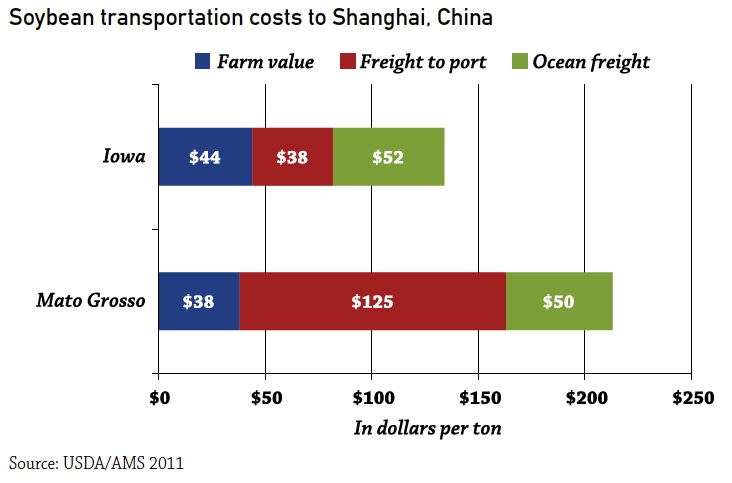July 26, 2013

Brazil’s larger corn and soybean crops strain its already-inadequate transportation system. That hinders Brazil’s ability to deliver promptly at a competitive price – and infrastructure improvements aren’t advancing quickly enough to ease the problem in the near future.
The situation:
Storage capacity for corn and soybeans is believed to accommodate less than half of production, forcing Brazil to move commodities at harvest.
An estimated 60% of Brazil’s soybeans and a large share of the corn move from farm to export terminal by truck. The distance from Brazil’s interior states to export terminals can span 1,200 miles.
A 15-mile-long line of trucks waiting to unload set a new record this year.
Compared to other exporters, Brazilian producers are 20% less profitable because of transportation inefficiencies, according to the Brazilian National Confederation of Agriculture.
Like what you're reading? Subscribe to CSD Extra and get the latest news right to your inbox!
New complications this year:
The price of diesel fuel jumped 5.4% in January and an additional 5% in March.
A new law requires truck drivers to take a half-hour break every four hours and rest 11 hours out of every 24. Nearly 50,000 additional drivers are needed to maintain transport capacity under the rule, at a time when Brazil’s unemployment rate is at an all-time low.
Corn exports, normally complete by December, were still moving through Brazil’s ports in late March and competing for transit space with soybean exports.
In one year (from April 2012 to April 2013), freight prices increased by 68% from Maringá, Paraná, to the port of Paranaguá. The average price by April 2013 was $38 per metric ton ($1.03 per bushel). At the end of April, it cost about $128 to move a metric ton of soybeans from Sorriso, Mato Grosso, to the port of Paranaguá (about $3.48 per bushel).
Efforts are underway to improve Brazil’s transportation infrastructure:
Private company investment in northern and northeastern ports to reduce dependence on the Santos and Paranaguá ports.
Public sector initiatives to improve grain movement to the ports – but most of these projects are years from completion.
Railway development: The 600-mile Central Atlantic Railway to connect Anápolis to Santos is only 53% complete.
The cost to modernize roads was 19 times the government’s budget for road improvements in 2012, according to the Brazilian Institute of Logistics. Brazil’s investment in transportation improvements has fallen from 1.8% of GDP 35 years ago to just 0.8%.
A Rabobank study suggests Brazil’s grain and soybean transportation system will continue to struggle through at least the 2013/14 crop year.
Sources: Rabobank, The Road to Ruin: Brazil’s Agribusiness Logistics in 2013, and USDA-Foreign Agricultural Service, Brazilian Agricultural Exports Face Growing Constraints.
You might also like:
Growers Seek More Precision Ag from Retailers
7 Tips to Manage Palmer Amaranth
Make GPS Agronomic Data Easier to Understand with Maps
About the Author(s)
You May Also Like




